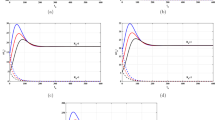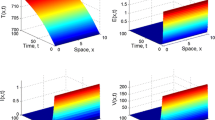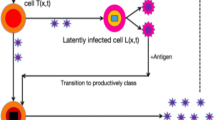Abstract
In this paper, we incorporate the Beddington–DeAngelis incidence rate to a continuous-time HIV infection model with cure rate and a full logistic proliferation rate of \(CD4^+\) T cells in both uninfected and infected cells. Equilibria and their local stability analysis are discussed. It is shown that the HIV-free equilibrium point is locally asymptotically stable if \({\mathcal {R}}_0<1\) and unstable if \({\mathcal {R}}_0\ge 1\), where \({\mathcal {R}}_0\) is the basic reproduction number. Whereas, the HIV equilibrium point is locally asymptotically stable if \({\mathcal {R}}_0>1\). A nonstandard finite difference method is applied to the continuous model to obtain its discrete counterpart. The scheme applied preserves the main features of the continuous model such as positivity, boundedness of the solutions, equilibria and their local stability. Moreover, an optimal control strategy is applied to the discrete-time model in order to reduce the number of infected cells as well as the number of free HIV particles. Numerical simulations are performed to verify the theoretical analysis obtained.







Similar content being viewed by others
References
D.M. Imboden, S. Pfenninger, Introduction to Systems Analysis: Mathematically Modeling Natural Systems (Springer, Berlin, 2013)
B.P. Ingalls, Mathematical Modeling in Systems Biology: An Introduction (MIT Press, London, 2013)
A. Eladdadi, P. Kim, D. Mallet, Mathematical Models of Tumor-Immune System Dynamics (Springer, New York, 2014)
S.M. Salman, E. Ahmed, A mathematical model for Creutzfeldt Jacob Disease (CJD). Chaos Solitons Fract. 116, 249–260 (2018)
A.S. Perelson, A.U. Neumann, M. Markowitz, J.M. Leonard, D.D. Ho, HIV-1 dynamics in vivo: virion clearance rate, infected cell life-span, and viral generation time. Science 271, 1582–1586 (1996)
M.A. Nowak, S. Bonhoeffer, G.M. Shaw, R.M. May, Anti-viral drug treatment: dynamics of resistance in free virus and infected cell populations. J. Theor. Biol. 184, 203–217 (1997)
S. Bonhoeffer, R.M. May, G.M. Shaw, M.A. Nowak, Virus dynamics and drug therapy. Proc. Natl. Acad. Sci. USA 94, 6971–6976 (1997)
M.A. Stafford, L. Corey, Y.Z. Cao, E.S. Daar, D.D. Ho, A.S. Perelson, Modeling plasma virus concentration during primary HIV infection. J. Theor. Biol. 203, 285–293 (2000)
L. Guihua, J. Zhen, Global stability of a SEIR epidemic model with infectious force in latent, infected and immune period. Chaos Solitons Fract. 25(5), 1177–1184 (2005)
A. Tripathi, R. Naresh, D. Sharma, Modelling the effect of screening of unaware infectives on the spread of HIV infection. Appl. Math. Comput. 184, 1053–1068 (2007)
Z. Mukandavire, A.B. Gumel, W. Garira, J.M. Tchuenche, Mathematical analysis of a model for HIV-Malaria co-infection. Math. Biosci. Eng. 6, 333–362 (2009)
E.A. Hernandez-Vargasa, R.H. Middleton, Modeling the three stages in HIV infection. J. Theor. Biol. 320, 33–40 (2013)
A. Mastroberardino, Y. Cheng, A. Abdelrazec, H. Liu, Mathematical modeling of the HIV/AIDS epidemic in Cuba. Int. J. Biomath. 08, 1550047 (2015). https://doi.org/10.1142/S1793524515500473
L. Cai, X. Li, M. Ghosh, B. Guo, Stability analysis of HIV/AIDS epidemic model with treatment. J. Comput. Appl. Math. 229, 313–323 (2009)
A.D. AlAgha, A.M. Elaiw, Stability of a general reaction-diffusion HIV-1 dynamics modelwith humoral immunity. Eur. Phys. J. Plus 134, 390 (2019). https://doi.org/10.1140/epjp/i2019-12740-9
G. Nazir, K. Shah, A. Debbouche, R.A. Khan, Study of HIV mathematical model under nonsingular kernel type derivative of fractional order. Chaos Solitons Fract. 139, 110095 (2020)
F. Haq, K. Shah, G.U.R.- Rahman, M. Shahzad, Numerical analysis of fractional order model of HIV-1 infection of CD4\(^+\) T-cells. Comput. Methods Differ. Equ. 5(1), 1–11 (2017)
S. Bushnaq, S.A. Khan, K. Shah, G. Zaman, Existence theory of HIV-1 infection model by using arbitrary order derivative of without singular kernel type. J. Math. Anal. 9(1), 16–28 (2018)
S. Bushnaq, S.A. Khan, K. Shah, G. Zaman, Mathematical analysis of HIV/AIDS infection model with Caputo-Fabrizio fractional derivative. Cogent Math. Stat. 5(1), 1432521 (2018)
S.M. Salman, Memory and media coverage effect on an HIV/AIDS epidemic model with treatment. J. Comput. Appl. Math. 385 (2021)
R. Luckheeram, R. Zhou, A. Verma et al., CD4\(+\) T cells: differentiation and functions. Clin. Dev. Immunol. 28, 445–489 (2012). https://doi.org/10.1155/2012/925135
J. Zhu, W.E. Paul, CD4 T cells: fates, functions, and faults. Blood 112(5), 15571569 (2008)
L.C. Wang, M.Y. Li, Mathematical analysis of the global dynamics of a model for HIV infection of \(CD4^+\) T cells. Math. Biosci. 200, 44–57 (2006)
X. Wang, X.Y. Song, Global stability and periodic solution of a model for HIV infection of \(CD4^+\) T cells. Appl. Math. Comput. 189, 1331–1340 (2007)
L. Cai, X. Li, Stability of Hopf bifurcation in a delayed model for HIV infection of CD4+ T-cells. Chaos Solitons Fract. 42, 1–11 (2009)
P.K. Srivastava, P. Chandra, Modeling the dynamics of HIV and \(CD4^+\) T cells during primary infection. Nonlinear Anal. Real World Appl. 11, 612–618 (2010)
S. Wang, P. Hottz, M. Schechter, L. Rong, Modeling the slow \(CD4^+\) T cell decline in HIV-infected individuals. PLoS. Comput. Biol. 11(12), e1004665 (2015)
H. Takata, C. Kessing, A. Sy, N. Lima, J. Sciumbata, L. Mori, R.B. Jones et al., Modeling HIV-1 latency using primary \(CD4^+\) T cells from virally suppressed HIV-1-infected individuals on antiretroviral therapy. J. Virol. 93, e02248–18 (2018). https://doi.org/10.1128/JVI.02248-18
A.S. Perelson, P.W. Nelson, Mathematical analysis of HIV-1 dynamics in vivo. SIAM Rev. 41, 3–44 (1999)
X.Y. Song, A.U. Neumann, Global stability and periodic solution of the viral dynamics. J. Math. Anal. Appl. 329, 281–297 (2007)
X. Liu, H. Wang, Z. Hu, W. Ma, Global stability of an HIV pathogenesis model with cure rate. Nonlinear Anal. Real World Appl. 12(6), 2947–2961 (2011)
X.Y. Zhou, X.Y. Song, X.Y. Shi, A differential equation model of HIV infection of \(CD4^+\) T-cells with cure rate. J. Math. Anal. Appl. 342, 1342–1355 (2008)
L.G. Guidotti, R. Rochford, J. Chung, M. Shapiro, R. Purcell, F.V. Chisari, Viral clearance without destruction of infected cells during acute HBV infection. Science 284, 825–829 (1999)
S. Lewin, T. Walters, S. Locarnini, Hepatitis B treatment: rational combination chemotherapy based on viral kinetic and animal model studies. Antivir. Res. 35, 381–396 (2002)
K.F. Wang, A.J. Fan, A. Torres, Global properties of an improved hepatitis B virus model. Nonlinear Anal. Real World Appl. 11, 3131–3138 (2010)
J.R. Beddington, Mutual interference between parasites or predators and its effect on searching efficiency. J. Anim. Ecol. 44, 331–340 (1975)
D.L. DeAngelis, R.A. Goldstein, R.V. ONeill, A model for trophic interaction. Ecology 56, 881–892 (1975)
A. Elaiw, I. Hassanien, S. Azoz, Global stability of HIV infection models with intracellular delays. J. Korean Math. Soc. 49, 779–794 (2012)
G. Huang, W. Ma, Y. Takeuchi, Global analysis for delay virus dynamics model with Beddington-DeAngelis functional response. Appl. Math. Lett. 24, 1199–1203 (2011)
X. Wang, Y. Tao, X. Song, A delayed HIV-1 infection model with Beddington-DeAngelis functional response. Nonlinear Dyn. 62, 67–72 (2010)
C. Lv, L. Huang, Z. Yuan, Global stability for an HIV-1 infection model with Beddington-DeAngelis incidence rate and CTL immune response. Commun. Nonlinear Sci. Numer. Simul. 19, 121–7 (2014)
Y. Liu, J. Xiong, C. Hu, C. Wu, Stability analysis for fractional differential equations of an HIV infection model with cure rate, in IEEE International Conference on Information and Automation (ICIA), Ningbo, pp. 707–711 (2016). https://doi.org/10.1109/ICInfA.2016.7831911
C.S. Holling, The components of predation as revealed by a study of small-mammal predation of the European pine sawfly. Can. Entomol. 91(5), 293–320 (1959). https://doi.org/10.4039/Ent91293-5
X. Song, A. Neumann, Global stability and periodic solution of the viral dynamics. J. Math. Anal. Appl. 329, 281–297 (2007)
Z. Hu, Z. Teng, H. Jiang, Stability analysis in a class of discrete SIRS epidemic models. Nonlinear Anal. Real World Appl. 13, 2017–2033 (2012)
A. Suryanto, A dynamically consistent nonstandard numerical scheme for epidemic model with saturated incidence rate. Int. J. Math. Comput. 13, 112–123 (2011)
A. Suryanto, Stability and bifurcation of a discrete SIS epidemic model with delay, in Proceedings of the 2nd International Conference on Basic Sciences, Indonesia, pp. 1–6 (2012)
Q. Cui, J. Xu, Q. Zhang, K. Wang, An NSFD scheme for SIR epidemic models of childhood diseases with constant vaccination strategy. Adv. Differ. Equ. 2014, 172 (2014)
K.E. Atkinson, W. Han, D.E. Stewart, Numerical Solution of Ordinary Differential Equations (Wiley, Portsmouth, 2009)
R.E. Mickens, Nonstandard Finite Difference Models of Differential equations (World Scientific Publishing Co., River Edge, 1994)
Y. Geng, J.H. Xu, J.Y. Hou, Discretization and dynamic consistency of a delayed and diffusive viral infection model. Appl. Math. Comput. 316, 282–295 (2018)
K. Hattaf, N. Yousfi, A numerical method for a delayed viral infection model with general incidence rate. J. King Saud Univ. Sci. 28, 368–374 (2016)
K. Hattaf, N. Yousfi, Global properties of a discrete viral infection model with general incidence rate. Math. Methods Appl. Sci. 39, 998–1004 (2016)
A. Korpusik, A nonstandard finite difference scheme for a basic model of cellular immune response to viral infection. Commun. Nonlinear Sci. Numer. Simul. 43, 369–384 (2017)
K. Manna, S.P. Chakrabarty, Global stability and a non-standard finite difference scheme for a diffusion driven HBV model with capsids. J. Differ. Equ. Appl. 21, 918–933 (2015)
P.L. Shi, L.Z. Dong, Dynamical behaviors of a discrete HIV-1 virus model with bilinear infective rate. Math. Methods Appl. Sci. 37, 2271–2280 (2013)
Y. Yang, J.L. Zhou, X.S. Ma, T.H. Zhang, Nonstandard finite difference scheme for a diffusive within-host virus dynamics model both virus-to-cell and cell-to-cell transmissions. Comput. Math. Appl. 72, 1013–1020 (2016)
J.L. Zhou, Y. Yang, Global dynamics of a discrete viral infection model with time delay, virus-to-cell and cell-to-cell transmissions. J. Differ. Equ. Appl. 23, 1853–1868 (2017)
X. Zhuang, Q. Wang, J. Wen, Numerical dynamics of nonstandard finite difference method for nonlinear delay differential equation. Int. J. Bifurc. Chaos. 28(11), 1850133 (2018)
P. van den Driessche, J. Watmough, Reproduction numbers and sub-threshold endemic equilibria for compartmental models of disease transmission. Math. Biosci. 180, 29–48 (2002)
J.S. Muldowney, Compound matrices and ordinary differential equations. Rocky Mt. J. Math. 20, 857–872 (1990)
J. Arino, C.C. McCluskey, P. van den Driessche, Global results for an epidemic model with vaccination that exhibits backward bifurcation. SIAM J. Appl. Math. 64, 260–276 (2003)
C.C. McCluskey, P. van den Driessche, Global analysis of two tuberculosis models. J. Dyn. Differ. Equ. 16, 139–166 (2004)
R.E. Mickens, Dynamics consistency: a fundamental principle for constructing nonstandard finite difference scheme for differential equation. J. Differ. Equ. Appl. 11, 645–653 (2005)
R.E. Mickens, Numerical integration of population models satisfying conservation laws: NSFD methods. J. Biol. Dyn. 1, 427–436 (2007)
S.N. Elaydi, An Introduction to Difference Equations. Undergraduate Texts in Mathematics, 2nd edn. (Springer, New York, 1999)
S. Jang, S. Elaydi, Difference equations from discretization of a continuous epidemic model with immigration of infectives. Can. Appl. Math. Q. 11, 93–105 (2004)
L. Edelstein-Keshet, Mathematical Models in Biology (McGraw-Hill, New York, 1988)
M.A. Khan, S.W. Shah, S. Ullah, J.F. Gomez-Aguilar, A dynamical model of asymptomatic carrier Zika virus with optimal control strategies. Nonlinear Anal. Real World Appl. 50, 144–170 (2019)
S. Ullah, M.A. Khan, J.F. Gomez-Aguilar, Mathematical formulation of hepatitis B virus with optimal control analysis. Optim. Control Appl. Methods 40(3), 529–544 (2019)
E. Bonyah, M.A. Khan, K.O. Okosun, J.F. Gomez-Aguilar, On the co-infection of dengue fever and Zika virus. Optim. Control Appl. Methods 40(3), 394–421 (2019)
E. Bonyah, M.A. Khan, K.O. Okosun, J.F. Gomez-Aguilar, Modelling the effects of heavy alcohol consumption on the transmission dynamics of gonorrhea with optimal control. Math. Biosci. 309, 1–11 (2019)
E. Bonyah, J.F. Gomez-Aguilar, A. Adu, Stability analysis and optimal control of a fractional human African trypanosomiasis model. Chaos Solitons Fract. 117, 150–160 (2018)
W.H. Fleming, R.W. Rishel, Deterministic and Stochastic Optimal Control (Springer, New York, 1975)
D.L. Lukes, Differential Equations: Classical to Controlled, Mathematics in Science and Engineering, vol. 162 (Academic Press, New York, 1982)
L.S. Pontryagin, V.G. Boltyanskii, R.V. Gamkrelidze, E.F. Mishchenko, The Mathematical Theory of Optimal Processes (Wiley, New York, 1962)
Acknowledgements
The author would like to thank the anonymous reviewers for providing valuable comments which helped to improve the original manuscript.
Author information
Authors and Affiliations
Corresponding author
Rights and permissions
About this article
Cite this article
Salman, S.M. A nonstandard finite difference scheme and optimal control for an HIV model with Beddington–DeAngelis incidence and cure rate. Eur. Phys. J. Plus 135, 808 (2020). https://doi.org/10.1140/epjp/s13360-020-00839-1
Received:
Accepted:
Published:
DOI: https://doi.org/10.1140/epjp/s13360-020-00839-1




